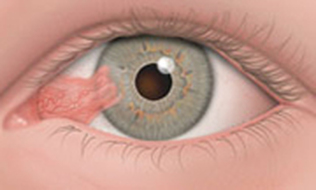Pterygium

Pterygium is a common, benign growth of the conjunctiva (the membrane covering the white part of your eye) over the cornea, the clear front part of the eye.
Even though we do not know why some people develop pterygium and some do not, it has been associated with exposure to UV light, wind and dusty conditions. It is more common in men than women, and in some demographic groups like Hispanics or populations living near the equator.
Pterygium can cause ocular irritation, redness or ocular foreign body sensation. It may make it impossible to wear contact lenses. When advanced or progressive, it can grow into the cornea and cause astigmatism or cover the visual axis and block your vision.
The best way to prevent the development or progression of pterygium is wearing sunglasses and a hat when outside, and treating associated dryness if present.
The treatment of pterygium starts with lubricating drops or antiinflammatory agents. If this is not enough to control discomfort or if it is growing into the cornea and threatening your vision, your doctor may recommend surgery.
The surgery for pterygium involves the resection of the pterygium tissue. To prevent recurrence, your doctor may choose to perform a conjunctival autograft from healthy tissue in the same eye or use amniotic membrane grafting or mytomycin C.
Rarely some other types of conjunctival growths may masquerade as a pterygium. Always check with your ophthalmologist if ocular redness or discomfort.
Even though we do not know why some people develop pterygium and some do not, it has been associated with exposure to UV light, wind and dusty conditions. It is more common in men than women, and in some demographic groups like Hispanics or populations living near the equator.
Pterygium can cause ocular irritation, redness or ocular foreign body sensation. It may make it impossible to wear contact lenses. When advanced or progressive, it can grow into the cornea and cause astigmatism or cover the visual axis and block your vision.
The best way to prevent the development or progression of pterygium is wearing sunglasses and a hat when outside, and treating associated dryness if present.
The treatment of pterygium starts with lubricating drops or antiinflammatory agents. If this is not enough to control discomfort or if it is growing into the cornea and threatening your vision, your doctor may recommend surgery.
The surgery for pterygium involves the resection of the pterygium tissue. To prevent recurrence, your doctor may choose to perform a conjunctival autograft from healthy tissue in the same eye or use amniotic membrane grafting or mytomycin C.
Rarely some other types of conjunctival growths may masquerade as a pterygium. Always check with your ophthalmologist if ocular redness or discomfort.
